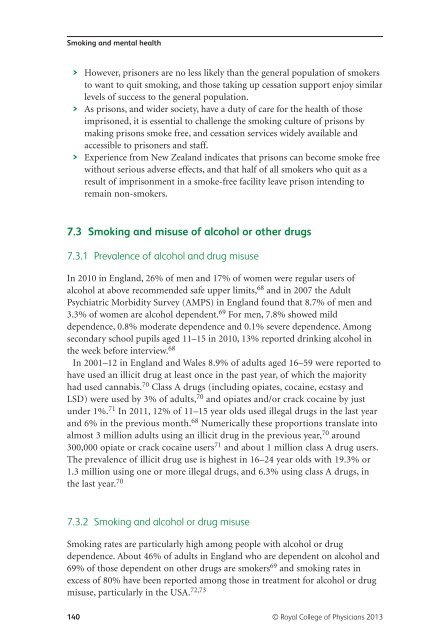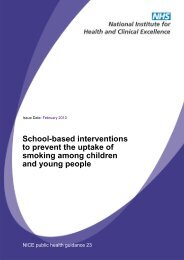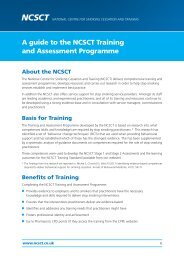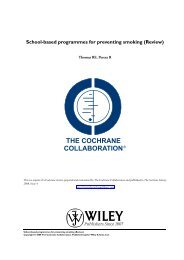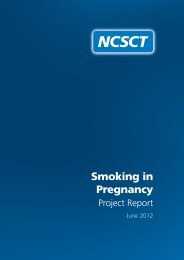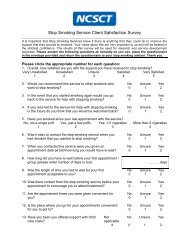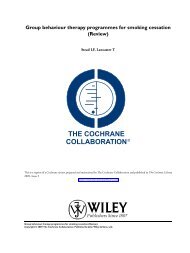Smoking and mental health - NCSCT
Smoking and mental health - NCSCT
Smoking and mental health - NCSCT
You also want an ePaper? Increase the reach of your titles
YUMPU automatically turns print PDFs into web optimized ePapers that Google loves.
<strong>Smoking</strong> <strong>and</strong> <strong>mental</strong> <strong>health</strong><br />
> However, prisoners are no less likely than the general population of smokers<br />
to want to quit smoking, <strong>and</strong> those taking up cessation support enjoy similar<br />
levels of success to the general population.<br />
> As prisons, <strong>and</strong> wider society, have a duty of care for the <strong>health</strong> of those<br />
imprisoned, it is essential to challenge the smoking culture of prisons by<br />
making prisons smoke free, <strong>and</strong> cessation services widely available <strong>and</strong><br />
accessible to prisoners <strong>and</strong> staff.<br />
> Experience from New Zeal<strong>and</strong> indicates that prisons can become smoke free<br />
without serious adverse effects, <strong>and</strong> that half of all smokers who quit as a<br />
result of imprisonment in a smoke-free facility leave prison intending to<br />
remain non-smokers.<br />
7.3 <strong>Smoking</strong> <strong>and</strong> misuse of alcohol or other drugs<br />
7.3.1 Prevalence of alcohol <strong>and</strong> drug misuse<br />
In 2010 in Engl<strong>and</strong>, 26% of men <strong>and</strong> 17% of women were regular users of<br />
alcohol at above recommended safe upper limits, 68 <strong>and</strong> in 2007 the Adult<br />
Psychiatric Morbidity Survey (AMPS) in Engl<strong>and</strong> found that 8.7% of men <strong>and</strong><br />
3.3% of women are alcohol dependent. 69 For men, 7.8% showed mild<br />
dependence, 0.8% moderate dependence <strong>and</strong> 0.1% severe dependence. Among<br />
secondary school pupils aged 11–15 in 2010, 13% reported drinking alcohol in<br />
the week before interview. 68<br />
In 2001–12 in Engl<strong>and</strong> <strong>and</strong> Wales 8.9% of adults aged 16–59 were reported to<br />
have used an illicit drug at least once in the past year, of which the majority<br />
had used cannabis. 70 Class A drugs (including opiates, cocaine, ecstasy <strong>and</strong><br />
LSD) were used by 3% of adults, 70 <strong>and</strong> opiates <strong>and</strong>/or crack cocaine by just<br />
under 1%. 71 In 2011, 12% of 11–15 year olds used illegal drugs in the last year<br />
<strong>and</strong> 6% in the previous month. 68 Numerically these proportions translate into<br />
almost 3 million adults using an illicit drug in the previous year, 70 around<br />
300,000 opiate or crack cocaine users 71 <strong>and</strong> about 1 million class A drug users.<br />
The prevalence of illicit drug use is highest in 16–24 year olds with 19.3% or<br />
1.3 million using one or more illegal drugs, <strong>and</strong> 6.3% using class A drugs, in<br />
the last year. 70<br />
7.3.2 <strong>Smoking</strong> <strong>and</strong> alcohol or drug misuse<br />
<strong>Smoking</strong> rates are particularly high among people with alcohol or drug<br />
dependence. About 46% of adults in Engl<strong>and</strong> who are dependent on alcohol <strong>and</strong><br />
69% of those dependent on other drugs are smokers 69 <strong>and</strong> smoking rates in<br />
excess of 80% have been reported among those in treatment for alcohol or drug<br />
misuse, particularly in the USA. 72,73<br />
140 © Royal College of Physicians 2013


